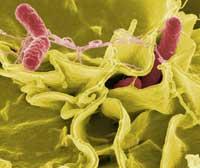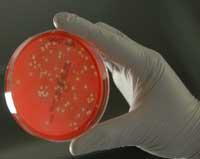Cutaneous biodiversity at sight

If we asked exactly where more species of bacteria are in the skin, probably many would bet on the axils. Well, all of them would be wrong. According to a new study, forearms are the parts of the skin that present the highest bacterial pounum.
So far no one had made the decision to compare bacterial diversity in different areas of the skin. Conducted at the Maryland National Human Genome Research Institute, ten volunteers were selected for the study of the skin.
A total of 1,000 species were found in the skin and, as has been said, they have seen that the largest number of bacteria is concentrated in the forearm. The youngest, behind the ear. In addition, it has been observed that in the fat parts of the body, such as the forehead, less species of bacteria grow than in the dry ones.

All cells of the body have ten times these bacteria in the body: in the intestine, in the mouth, even in the skin (Photo: Rocky Mountain Laboratories)
With advanced techniques
To identify all the species of bacteria present in the skin, scientists did not resort to conventional techniques. Traditionally, they were identified by taking samples of the skin, their growth in laboratory conditions, and their study. This time they have resorted to the sequencing of genes.
Thus, scientists have assured that they study all the bacteria. In fact, when analyzing laboratory seeds, they could not ensure that all existing bacteria were being studied, as some of them grow more easily than others in laboratory conditions.
Before starting the study, ten chosen volunteers were called to clean it with a soap for a week. Then they had to spend a whole day without bathing and then took samples of twenty places of the body, among which were the nostrils, the navel and the rear.
In the samples taken, the genomes were not analyzed, that is, they were not directly resorted to bacterial DNA. On the contrary, the ribosomal RNA was analyzed, a part of the system that participates in the process of transforming the information contained in the genes into proteins. Based on the differences between existing species in this RNA, the 1,000 species mentioned were differentiated.
The results have shown that human skin is not a homogeneous medium for bacteria, that is, that bacteria are not found in one or another area of the skin.

However, researchers do not know why there are richer differences in number of species than others. They think, for example, that the amount of skin hair and its oily character or not, can have a great influence on the fact that bacteria hit a certain part of the body as a place of residence.
In addition to the comfort conditions offered by some parts of the skin to bacteria, experts consider it logical that the greatest bacterial richness is found in areas with greater contact with extracorporic bacteria. Many times the forearms are in contact with bacteria like the hands, but more often we clean hands with soap than the forearms. Or do you also soak your forearms whenever you wash your hands?
Combining these reasons, our body becomes a very diverse ecosystem for bacteria, and forearms, suitable places to land in this ecosystem.
Published in 7K.
Buletina
Bidali zure helbide elektronikoa eta jaso asteroko buletina zure sarrera-ontzian











